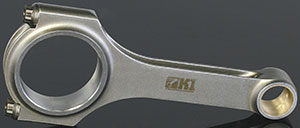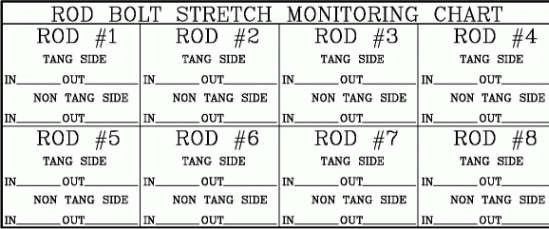 |
||||||||||||||||||||||||||||||||||||||||||||||
K1 Technologies Connecting Rods Installation and Bolt Tightening
Rod Assembly , Rod Bolt Stretch, Torque and Angle SpecificationsPlease follow these guidelines and installation instructions to insure the best possible service life from your K1 connecting rods. FAILING TO FOLLOW THESE INSTRUCTIONS CAN RESULT IN ENGINE FAILURE!!!Connecting Rod Installation: Getting StartedBefore loosening the fasteners and removing the caps from your con rods, be sure to number the rod and matching cap so you can reassemble the correct cap to its matching rod body. DO NOT use metal stamps or any type of impact tool to mark the connecting rods and caps! Do not swap the conrods and caps. The rod and cap is carefully machined together to very precise tolerances. Every cap and rod assembly is unique and the respective parts can not be exchanged. Be careful to keep the parts identifiable so they can be properly put back together just as you receive them from the manufacturer. Always separate the parts, then carefully clean all rod and attaching hardware surfaces before assembly and installation. 
CLEARANCES: Rod bearing clearance is controlled by the two pieces of bearing shells, not by the housing bore diameter of the connecting rod. The rod housing bore diameter determines the amount of bearing crush and prevents the bearing from moving once the rod is installed. Plasticgage is not recommended for checking bearing clearance. The most precise way to measure the housing bore of the rod is by using a dial bore gauge. Then use a micrometer to measure the crankshaft journal to verify you have the recommended clearance. In most applications, .001” per inch of crankshaft diameter is recommended when measured at the crown of the engine bearing. Engine Connecting Rod AssemblyAssemble the cap on the rod by hand and make certain that the alignment dowels register with the counter bores in the rod body. Then take a rubber or plastic hammer and gently tap the cap on until it is fully seated. When you are ready to tighten the fasteners apply lubricant to the threads and also the under head of the cap screw with the grease provided with the rod set. Never use Loctite on connecting rod hardware. Carefully clean all pieces to get rid of debris and oil or grease residue. Distribute the manufacturer supplied bolt lubricant on the fastener threads and under head of bolt and then tighten per the below instructions. Bolts and cap screws act similar to very stiff springs. Stretching them the prescribed distance provides the necessary clamping load required to keep the respective parts firmly attached even under high load conditions. Using the rod bolt torque method to tighten rod boltsA torque wrench is the first tool most people think of when they want to tighten a fastener to a certain, pre determined amount. Unfortunately, a torque wrench does not provide the most accurate, consistent, repeatable way to get the same exact amount of stretch and clamp load on a fastener. When you use a torque wrench to measure connecting rod fastener torque you are not only measuring clamp load, but also friction. A torque wrench measures the level of friction that must be overpowered to rotate the fastener. The friction of the mating surfaces of the threads, as well as the contact at the spot face and fastener flange vary with each use. When you take into account that various quantities and diverse types of lubricants also alter friction, using the torque method is similar to attempting to nail a moving target with limited vision. Because of the many inconsistencies with using a torque wrench, K1 Technologies does not recommend the use of nor provide specific torque values for tightening bolts. Instead, they recommend a better, more accurate process. Measuring Rod Fastener Stretch and Torque AngleThe bolt stretch system or the torque and angle technique are both more precise ways to properly tighten engine fasteners, and especially rod bolts or capscrews. The stretch method requires that you measure and write down the free length of the fastener, with no load on it. The easiest way to do this is with a rod bolt stretch gauge, but a standard micrometer with ball end attachments will also suffice. Use the chart below for reference and tighten the fastener until the proper stretch value is reached. It is highly recommended that you print out and make use of a rod fastener record similar to the one displayed at the bottom of this page to record the dimensions. To use the torque and angle method, simply torque the bolts the amount listed in the chart below then, using a Snap-On #TA360 torque angle gauge, turn the bolt the listed number of degrees.
Connecting Rod Bolt Stretch Log Sample
We would like to thank K1 Technologies for allowing us to post this connecting rod bolt tightening reference information on our website.
|
||||||||||||||||||||||||||||||||||||||||||||||
|
| ||||||||||||||||||||||||||||||||||||||||||||||
|
|
||||||||||||||||||||||||||||||||||||||||||||||
copyright © 2010 Motorsports Parts Corporation / ConnectingRods.Net All Rights Reserved |
||||||||||||||||||||||||||||||||||||||||||||||

